|
Housing of sheep and goatsGeneral considerations for sheep and goat housing
|
|||||||||||||||||||||||||||||||||||||||||||||||||||||||||||||||||||||||||||||||||||||||||||||||||||||||||||||||||||||||||||||||||||||||
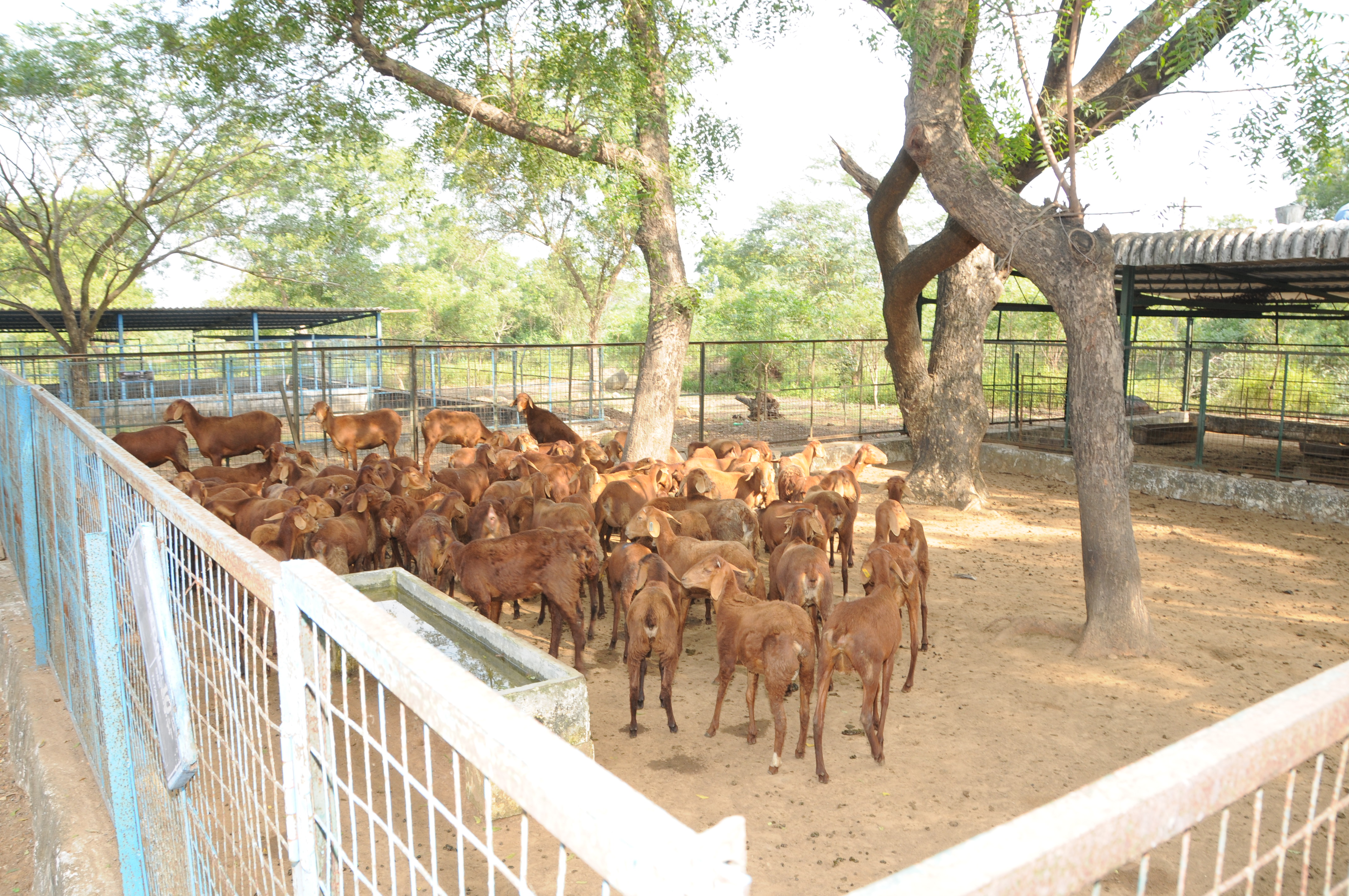 |
|
Low cost house |
Open type housing with run space |
Sheep in open space |
Fodder Cultivation near by shed |
- Provision of simple shed with low cost housing materials is enough for sheep and goat for its optimum production efficiency.
- Sheds with mud floor are suitable for most of parts of the country except where high rainfall is observed.
- The sheds should be constructed in an elevated area to prevent water stagnation.
- Fodder trees can be grown around the shed, which acts as a source of feed for the growing goats.
- Clean drinking water should be available for goats.
- Sheds should be constructed with proper ventilation.
- Walls of the shed should be free from cracks or holes, while constructing.
- Floors of the shed should be firm and should have the capacity to absorb water. The floors should be constructed in such a way, so that it should be easily cleaned.
- Types of sheds depend on the system of rearing.
- Open type housing with a covered area and run space is generally enough.
- The run space should be covered by chain links.
- The covered area is used for shelter of animals during night and adverse climatic conditions.
- For a comfortable house east-west orientation with generous provision for ventilation /air movement to dry the floor will be suitable.
- Thatched roof is best suited one due to cheaper cost and durability.
- However corrugated asbestos sheets can also be used for organized farms to minimize the recurring costs andto have longer durability.
- Gable roofing is generally preferred.
- For small sheds lean to type roofing is advisable.
- When the animals are taken for grazing during the day time and sheltered only during night, the covered space will be enough.
- When the animals are housed intensively, the pen and run system of housing is suitable.
- There is no restriction for the length of the shelter, however breadth of shed should not exceed 12 meter and optimum breadth of shelter is 8 meter.
- Height of ewe should be 2.5 meter and height at ridge should be 3.5 meter.
- The height of chain link used for open space should be 4 feet. The length of the overhang should be 75cm – 1 meter.
- Separate feeders and water troughs should be placed for concentrate feeds, green fodders and water.
Floor space requirements
Recommended floor space requirements for Indian conditions| Age groups | Covered space(sq.m) | Open space (sq.m) |
| Up to 3 months | 0.2-0.25 | 0.4-0.5 |
| 3 months to 6 months | 0.5-0.75 | 1.0-1.5 |
| 6 months to 12 months | 0.75-1.0 | 1.5-2.0 |
| Adult animal | 1.5 | 3.0 |
| Male, Pregnant or lactating ewe/ doe | 1.5-2.0 | 3.0- 4.0 |
Floor space requirement per animal (BIS standard)
| Types of animals | Minimum floor space per animal (59.m) |
| Ram or buck in groups | 1.8 |
| Ram or buck - individual | 3.2 |
| Lambs or kids - in group | 0.4 |
| Weaner in groups | 0.8 |
| yearling or goatlings | 0.9 |
| Ewe or doe in groups | 1.0 |
| Ewe with lamb | 1.5 |
Feeding and watering space requirement
| Type of animal | Space per animal (cm) | Width of manger/ water trough(cm) |
Depth of manger/ water trough (cm) |
Height of inner wall of manger/ water trough (cm) |
| Sheep and goat | 40 - 50 | 50 | 30 | 35 |
| Kid/lamb | 30 - 35 | 50 | 20 | 25 |
Sheds
Different sheds in an organized sheep and goat farm
The sheds of the following types are required for housing the animals,
- General flock shed (Ewe / Doe shed)
- Ram or buck shed
- Lambing or kidding shed
- Lamb or kid shed
- Sick animal shed
- Shearing and storeroom
- Attendant's room
General flock shed (Ewe / Doe shed)
 |
 |
 |
- The flock shed shall be used for housing ewes or does kept for breeding purpose.
- The shed shall be 15m (l) x 4m (w) x 3 m (h) and can accommodate not more than 60 ewes or does.
- The shed should be three metre high and should have brick-on-edge floor.
- In low lying and heavy rainfall areas, the floors should preferably be elevated and in temperate regions they may be made of strong wood.
Ram / buck shed
 |
 |
- Rams or bucks kept for breeding purpose are housed individually in these sheds. Alternatively, wooden partitions can be raised in bigger shed to partition in to stalls.
- The dimension is of 4m (l) ×2.5m (w) ×3m (h) and can accommodate about 3 rams/ bucks.
- The shed shall be partitioned lengthwise to form three equal compartments.
- The partition between each shed should not exceed one metre.
- The partitions may be either of wooden planks or half-cut ballis.
- The partition shall be not more than one metre high from the floor.
Lambing / kidding shed
 |
 |
 |
 |
- These sheds shall be used as maternity rooms for pregnant ewe or doe and are housed individually in these sheds.
- The shed shall be 1.5m(l)×1.2m(w)×3.0m(h), a manger for holding feed and hay and a bucket for keeping water shall be provided in the shed.
- These sheds shall be made draught free.
- In cold climates some warming device, like a room heater shall be fixed in maternity pens, so that new borns are protected from cold during winter.
Lamb/ kid shed
 |
 |
 |
 |
- Lambs or kids from weaning upto attaining maturity are housed in these sheds at the rate of about 25 animals per shed.
- By making suitable partitions in a larger shed, unweaned, weaned but immature and nearby maturity lambs can be housed separately.
- On larger farms however, three separate sheds may be constructed to house three categories of kids or lambs.
- The shed shall be with a dimension of 7.5m (l) ×4m (w) ×3m (h) to accommodate not more than 75 animals.
- The shed shall be partitioned breadth wise dividing into two compartments. The compartments having dimension of 5m (l) ×4m (w) ×3m (h) shall be used to keep the unweaned animals and other compartment with dimension of 2.5m(l)×4m(w) x3m(h) shall be used for keeping the weaned animals.
Sick animal shed
 |
 |
- There shall be a sick animal shed for segregating ailing and disabled animals.
- Away from the other sheds one or more sick animal sheds may be constructed with a dimension of 3m (l) ×2m (w) × 3 m (h).
- The lower half of the door may be made of wooden planks and the upper half of wire-netting.
- There may also be a window of 0.7 m broad and 1.2 m high with a wire net covering.
Shearing and storeroom
- The shearing and storeroom consist of two compartments with a dividing wall.
- One room may be exclusively meant for storing wool and shearing equipment and the other for keeping feed and medicines.
- The other room used for shearing may be 6m (l) x 2.5m (w) x 3m (h).
- There shall be a door one metre wide and two metres high in front side of the room.
- The door leaf may be made of wooden battens. It may also have two windows, one on each side of the long sides of the room.
- This room should have clean smooth floors and walls lined with glazed tiles upto a height of one and half metre.
- The room should be made damp and dust proof.
- There shall be three windows on three sides.
Attendant's room
- The shepherd's house meant for caretaker shall be located at a convenient place in the yard.
- The house may be 6m (l) X 4m (w) X 3 m (h). There shall be a door of one metre wide and two metres high on the long side of the shed facing the passage of the yard.
- The door leaf may be of wooden planks. There may be four windows; one of these facing the passage of the yard and the other three facing outside.
- Each window may be 0.7 m broad and 1.2 m high and covered with wire netting.
Dimensions of different sheds in a sheep and goat farm
| Name of the shed | lx w x h (m) | No. of animals Housed | Remarks |
| Ewe/ doe shed | 15 x 4 x 3 | 60 | - |
| Ram/ Buck shed | 4 x 2.5 x 3 | 8 | Make partition length wise |
| Lamb/ kid shed | 7.5 x 4 x 3 | 75 | Make partition width wise |
| Lambing/ kidding shed | 1.5 x 1.2 x 3 | 1 | Provide manger and waterer |
| Isolation / sick animal shed | 3 x 2 x 3 | 1 | Provide proper ventilation and bedding materials |
| Shearing shed | 6 x 2.5 x 3 | 1 | Make arrangement for storage of wool |
| Shepherd house | 6 x 4 x 3 | - | It should be located nearer to flock |
| Milch doe shed | 1.2 x 0.8 x 3 | 1 | - |
Units
Constructional details of different units
Floor
 |
- The flooring may be either of moorum or of strong wooden battens and, where the rainfall is quite heavy; the latter type of flooring may be preferred.
- In the case of wooden-batten flooring, the width of each plank shall vary from 7.5 to 10.0 cm and the thickness between 2.5 cm and 4.0 cm.
- The sides of the planks shall be well rounded and the clearance between two planks shall range between 1.0 cm and 1.5 cm to facilitate the disposal of dung and urine.
- The wooden-batten flooring shall be constructed at a height of at least one metre above the ground level.
- In this case, a suitable ramp or steps of wooden planks shall be provided.
- In the case of moorum flooring, a plinth wall between 15 cm and 30 cm in height shall be provided.
- For the shearing and store room and shepherd's house, the flooring may be of moorum or brick in cement mortar, and the floor shall be levelled properly.
Roof
- The roof may be made gabled.
- The roofing material may be either plain or corrugated galvanized steel sheets or asbestos cement sheets and where the rainfall is not heavy, it may be of thatch.
Gate
- Each shed may be provided with one or more gates either on the long or broad sides of the sheds depending upon the dimensions of the shed.
- The dimensions of each gate may be 0.8 m broad and one metre high. The gate leaf and frame may be made of wooden battens. It shall fit the entrance closely.
Manger
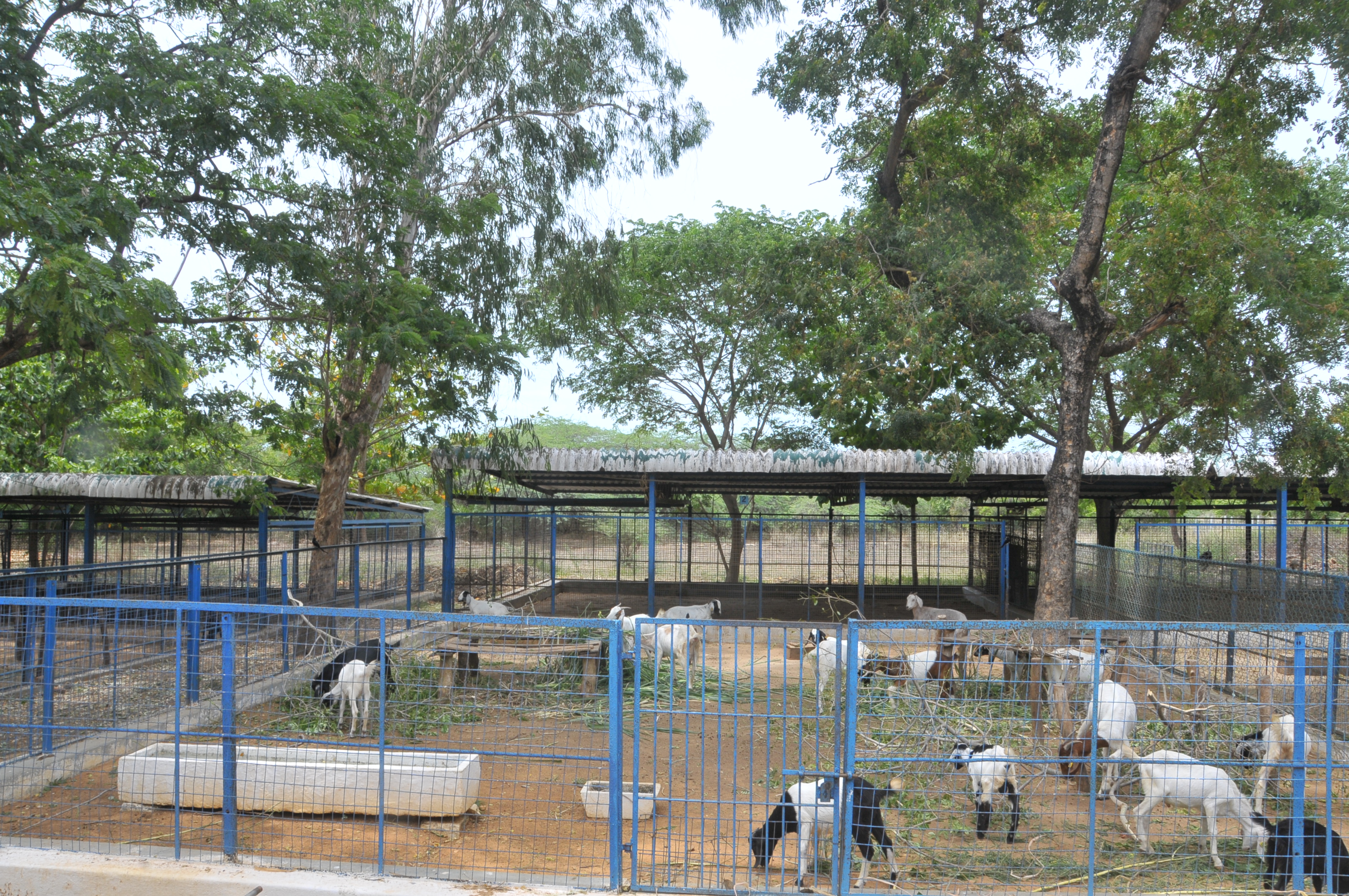 |
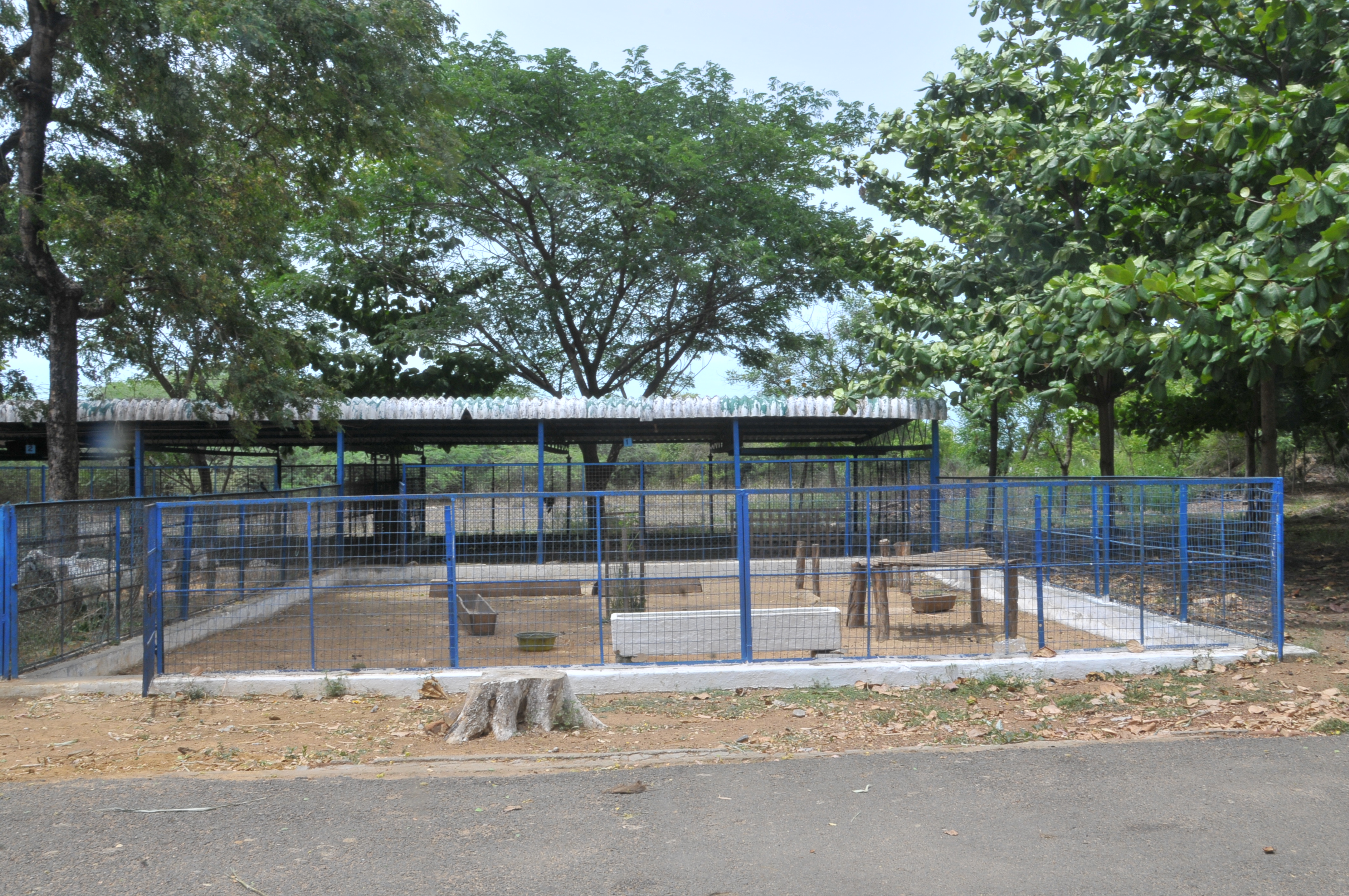 |
Manger and water trough |
Manger and water trough |
 |
|
| Manager and Water trough |
Manager and Water trough |
- The manger may be either of cement concrete or of wood with two compartments for providing feed and hay.
- A separate hay rack may also be provided by fixing at level or slightly below the heads of the animals.
- With the help of clamps, the manger may be raised within the height ranging between 450 and 600 mm from the ground.
- The water trough may be of cement concrete or galvanized steel pails or buckets and may be fixed or hung from a hook fixed to the walls.
- The manger may also be of portable type. The number of mangers and water troughs in each shed may vary according to the number of animals.
Dipping Tank
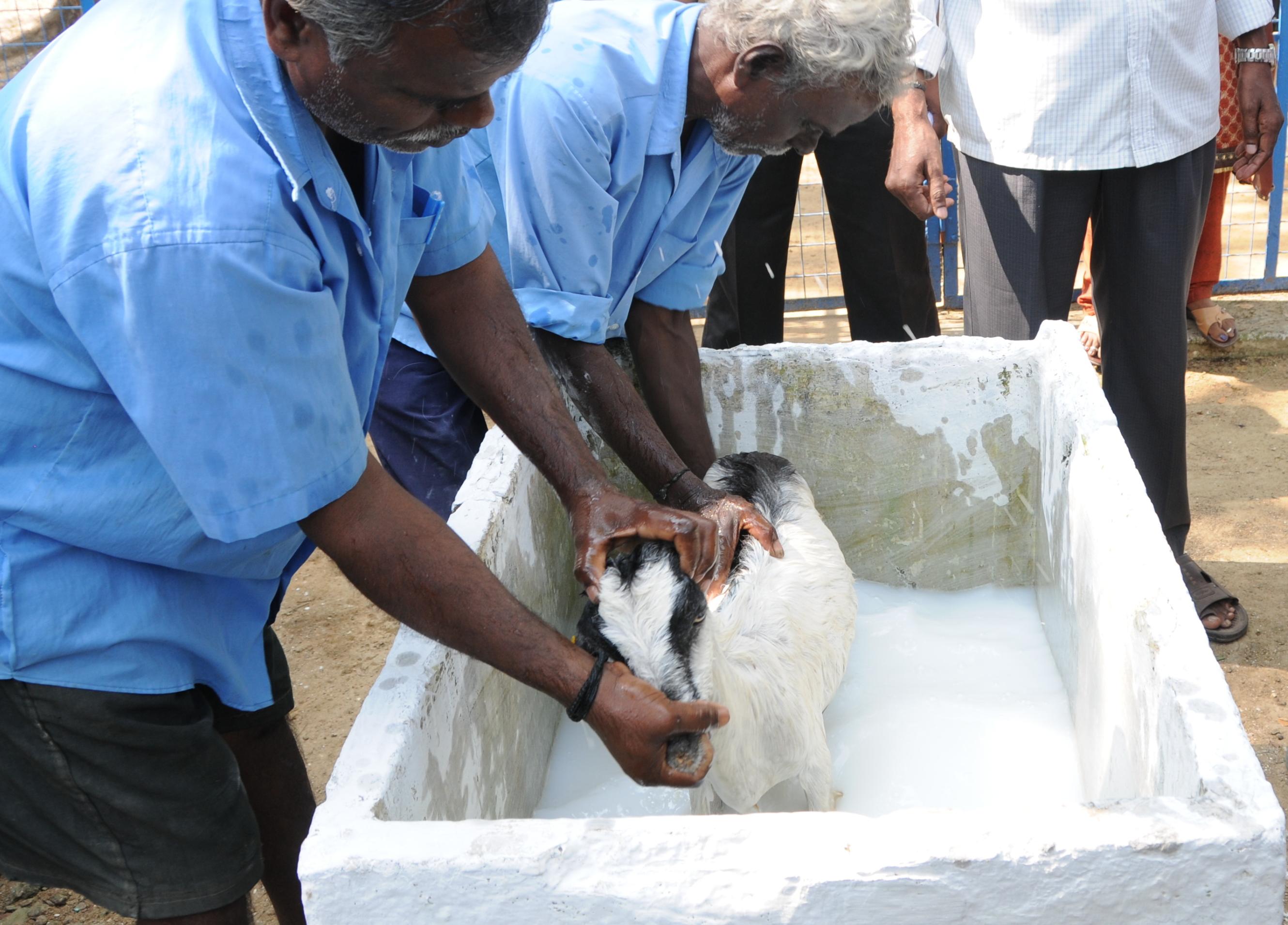 |
Dipping tank |
- To protect the animals from infection a dipping tank may be made either of galvanized steel sheets or constructed of stone or brick in cement mortar, whichever is likely to prove economical, according to local conditions.
- If a galvanized steel tank is used, it shall be well bedded down and the soil rammed tight against it to prevent the sides of the bath from bulging when it is filled.
- If the base of the soil is unstable, the tank may be bedded in cement concrete.
- The dipping tank may be at one side of the yard.
Footbath
- A footbath made of galvanized steel sheets or brick in cement mortar shall be provided at the entrance to the yard to protect the animals from foot-rot disease.
- These baths may be embedded in the soil suitably.
Rearing
Different systems of Sheep and Goat rearing
1. Extensive System
- Grazing the sheep and goat in the entire pasture and leaving them there for the whole season is the extensive system of rearing.
- In this method feed cost is very much reduced.
- It is not conducive to make the best use of the whole grasses. So we can preferably practice the rotational grazing method.
Rotational grazing method
- Rotational grazing should be practiced under which the pasture land should be divided by temporary fences into several sections.
- The animals are then moved from one section to another section. By the time the entire pasture is grazed, the first section will have sufficient grass cover to provide second grazing.
- Parasitic infestations can be controlled to a great extent.
- Further, it helps to provide quality fodder for most part of the year.
- Under this system, it is advisable to graze the lambs first on a section and then bring in ewes to finish up the feed left by the lambs.
2. Semi-intensive system
- Semi-intensive system of sheep / goat production is an intermediate compromise between extensive and intensive system followed in some flocks having limited grazing.
- It involves extensive management but usually with controlled grazing of fenced pasture.
- It consists of provision of stall feeding, shelter at night under shed and 3 to 5 hour daily grazing and browsing on pasture and range.
- In this method, the feed cost is somewhat increased.
This system has the advantage of
- Meeting the nutrient requirement both from grazing and stall feeding.
- Managing medium to large flock of 50 to 350 heads and above.
- Utilizing cultivated forage during lean period.
- Harvesting good crop of kids both for meat and milk.
- Making a profitable gain due to less labour input.
3. Intensive system-(zero grazing-system)
- It is a system in which sheep goats are continuously kept under housing in confinement with limited access in which they are stall fed.
- It implies a system where goats are not left to fend for themselves with only minimum care.
- Intensive operation of medium sized herd of 50 to 250 heads or more oriented towards commercial milk production goes well with this system particularly of dairy goats.
- It merits exploitation of the system of feeding agro-industrial by products as on fodder grass with carrying capacity of 37 to 45 goats per hectare.
- This system of management requires more labour and high cash input.
- However, this has the advantage of close supervision and control over the animals.
- In this method, the dung is collected in one place and used as a good fertilizer.
- Less space is sufficient for more number of animals.
Rearing in mud floor
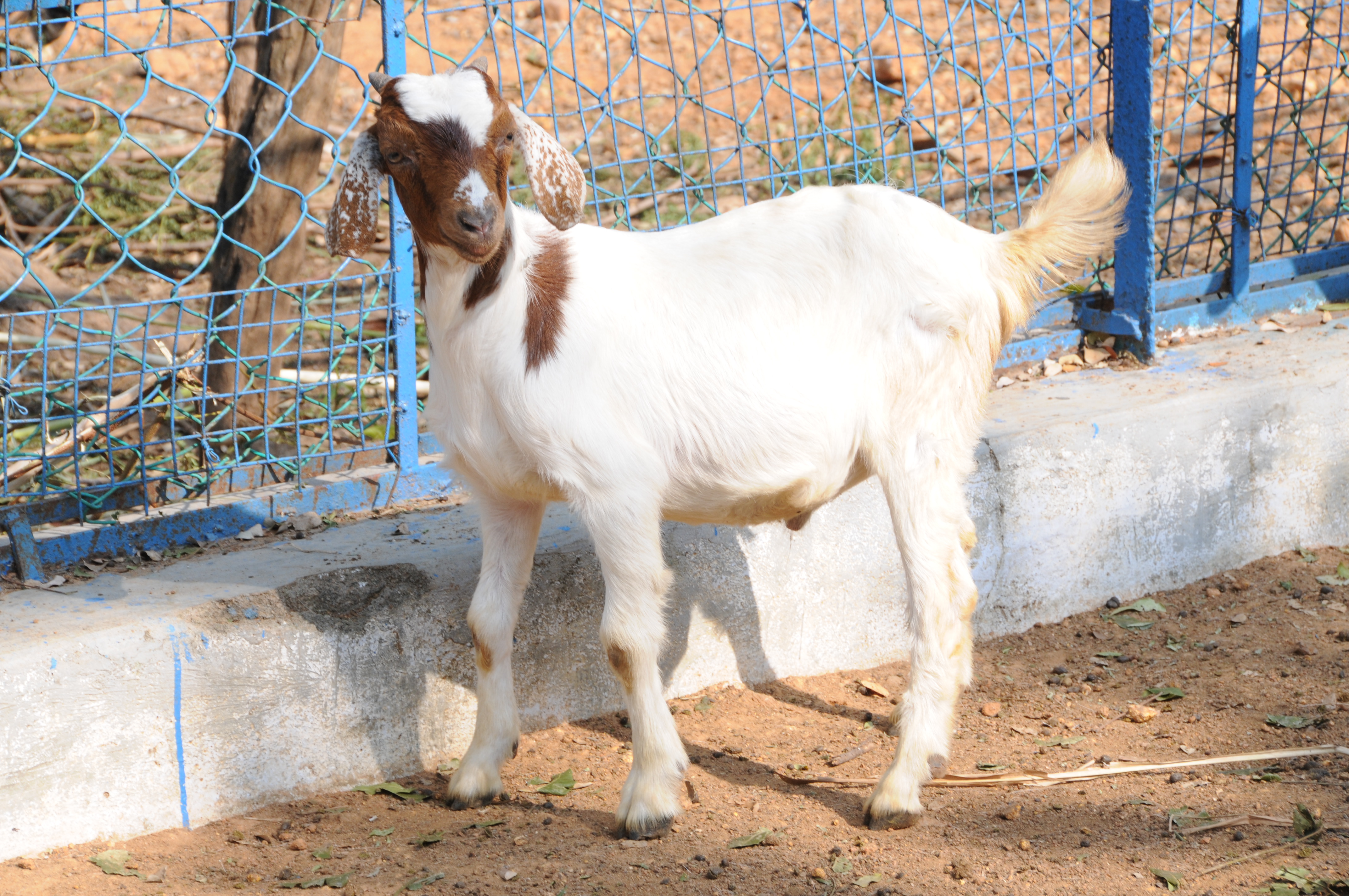 |
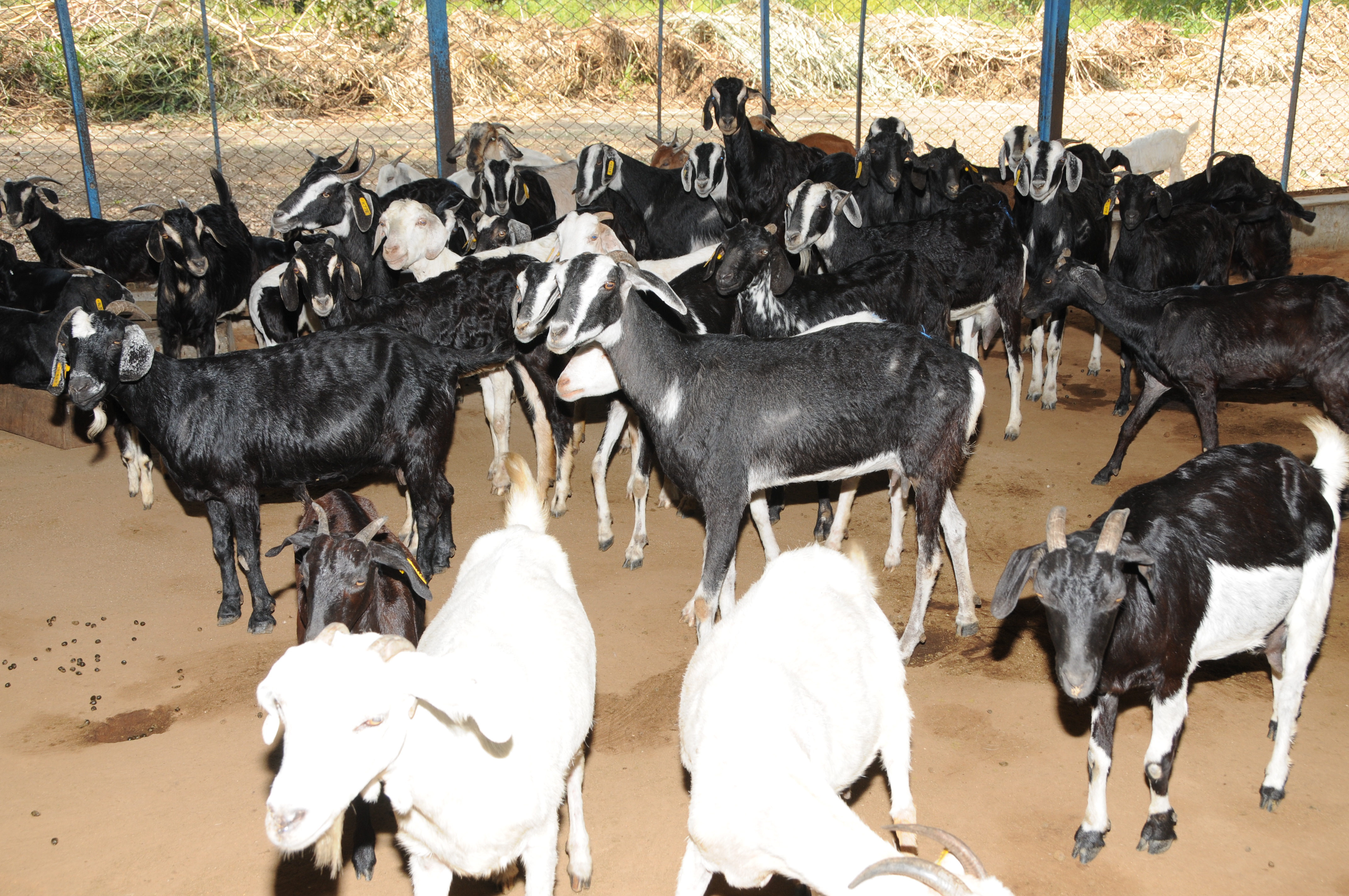 |
Mud Floor |
Mud Floor |
- In this method, once in a year 1-2 inches of mud surface should be removed.
- Application of lime powder once in a month will reduce the disease occurrence in the shed.
- The shed should be constructed in elevated area to prevent water stagnation.
Deep litter shed
- In this method, the litter materials like ground nut husk, sugarcane tops etc. are spread on the floor for a depth of ½ feet and animals are reared in it.
- The urine and dung mixed with the litter materials are used as fertilizer.
- The litter materials should be removed once in six months.
- In heavy rain seasons, the litter materials should not be over wet to prevent which would cause ammonia gas production.
Elevated floor shed
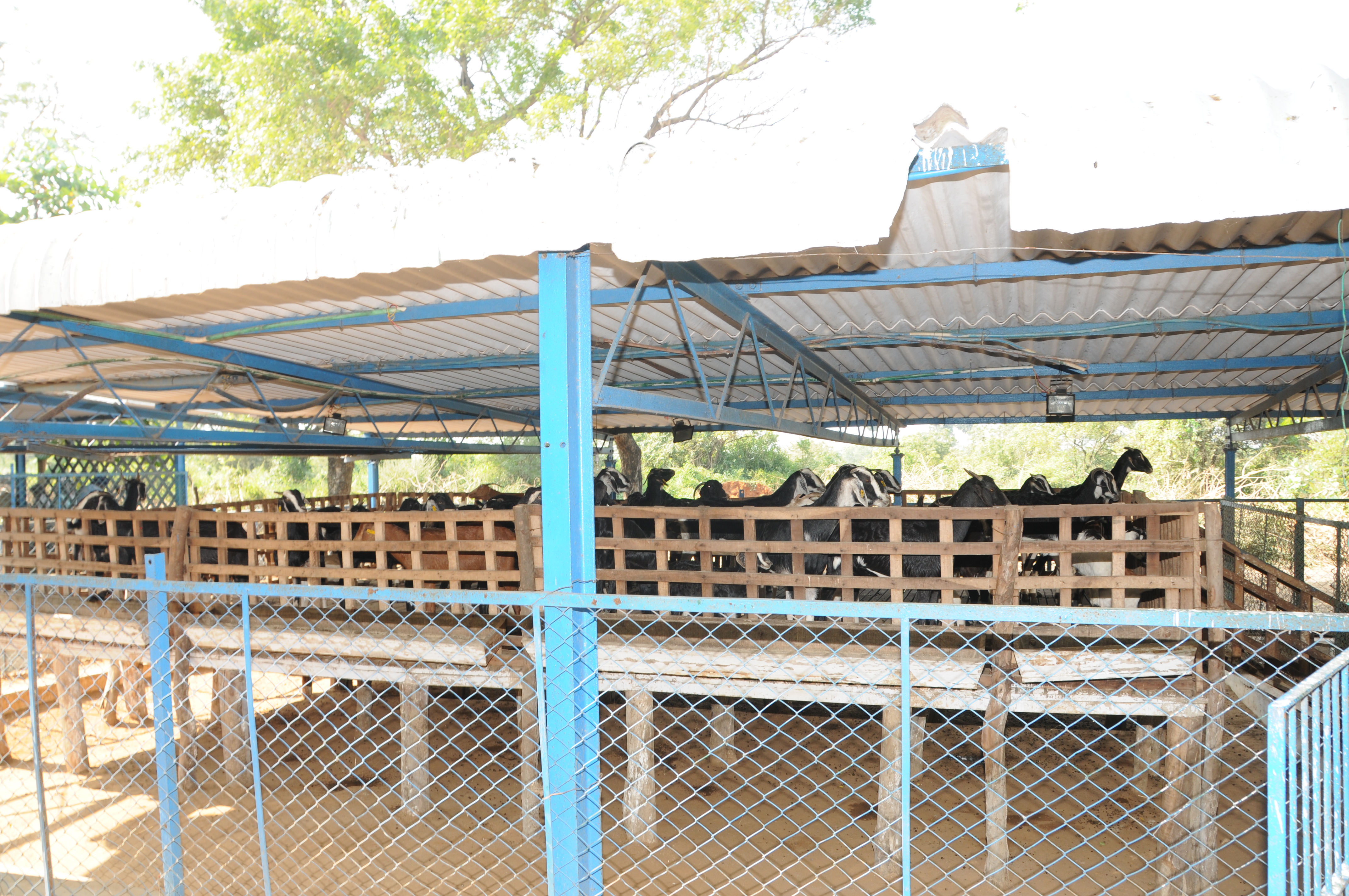 |
Elevated Floor |
- Its initial investment is high.
- In the wooden floor sheds, in a distance of 3m from the floor, the animals are reared.
- This requires less labour and more irrigation land for the fodder production.
- The elevated sheds will be clean and urine and dung will be collected in the floor and periodical removing is required once in six months.